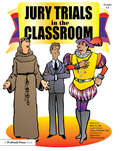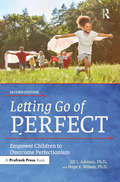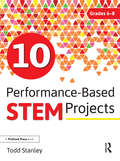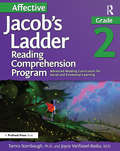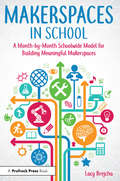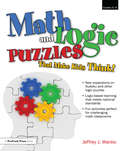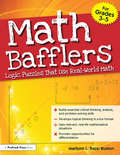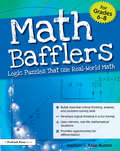- Table View
- List View
Jacob's Ladder Reading Comprehension Program: Grades 7-8
by Joyce VanTassel-Baska Tamra StambaughThe Jacob's Ladder Reading Comprehension Program targets reading comprehension skills in high-ability learners by moving students through an inquiry process from basic understanding to critical analyses of texts, using a field-tested method developed by the Center for Gifted Education at William & Mary. Students in grades 7-8 will learn to comprehend and analyze any reading passage after completing the activities in Jacob's Ladder, Grades 7-8 (2nd ed., previously published as Level 5).Using skill ladders connected to short stories, poetry, essays, and nonfiction, students move from lower order, concrete thinking skills to higher order, critical thinking skills. The ladders include multiple skills necessary for academic success, covering language arts standards such as sequencing, determining cause and effect, classifying, making inferences, and recognizing main ideas, themes, and concepts. The second edition of the book builds off the previous Level 5 edition, including new readings and ladders for student use.This book provides teachers with an explanation of the nature of supplementary tasks that scaffold reading comprehension. Also included is an overview of the goals and objectives of the Jacob's Ladder tasks and suggestions for implementation, giving every teacher the tools needed to promote successful reading comprehension.Optional Student Workbook PacksIn addition to this teacher's guide, companion student workbooks are available for Poetry, Short Stories, and Biographies. The student workbooks feature ample room for student responses and notes, make reviewing and providing feedback on student work easier than ever, provide students with an easy-to-use reference to use during discussions, and save time, as there is no need to reproduce student handouts.Grades 7-8
Jacob's Ladder Reading Comprehension Program: Grades K-1
by Joyce VanTassel-Baska Tamra StambaughThe Jacob's Ladder Reading Comprehension Program targets reading comprehension skills in high-ability learners by moving students through an inquiry process from basic understanding to critical analyses of texts, using a field-tested method developed by the Center for Gifted Education at William & Mary. Students in grades K-1 will learn to comprehend and analyze any reading passage after completing the activities in Jacob's Ladder, Grades K-1 (2nd ed.).Geared for students in grades K-1, this book, a revision of the Primary Level 1 book, includes stories and ladder tasks carefully selected for young children to develop oral communication and listening skills in addition to the other ladder goals. This book provides stories focused on picture analysis, read alouds, classics, and original works.Optional Student Workbook PacksIn addition to this teacher's guide, companion student workbooks are available for Grades K-1
Jacob's Ladder Reading Comprehension Program: Nonfiction Grade 3
by Joyce VanTassel-Baska Tamra StambaughThe Jacob's Ladder Reading Comprehension Program: Nonfiction targets reading comprehension skills in high-ability learners by moving students through an inquiry process from basic understanding to critical analyses of texts using a field-tested method developed by the Center for Gifted Education at William & Mary. Students in grade 3 will be able to comprehend and analyze any nonfiction reading passage after completing the activities in this book. Using skill ladders connected to individual readings related to essays, articles, comparison documents, infographics, and other nonfiction texts, students move from lower order, concrete thinking skills to higher order, critical thinking skills. All of the books, geared to increasing grade levels, include high-interest readings, ladders to increase reading skill development, and easy-to-implement instructions. The ladders include multiple skills necessary for academic success, covering language arts standards such as sequencing, cause and effect, classification, making generalizations, inference, understanding emotion, using and thinking about words, and recognizing themes and concepts.Optional Student Workbook PacksIn addition to this teacher's guide, companion student workbooks are available for Grade 3
Jacob's Ladder Reading Comprehension Program: Nonfiction Grade 4
by Joyce VanTassel-Baska Tamra StambaughThe Jacob's Ladder Reading Comprehension Program: Nonfiction targets reading comprehension skills in high-ability learners by moving students through an inquiry process from basic understanding to critical analyses of texts using a field-tested method developed by the Center for Gifted Education at William & Mary. Students in grade 4 will be able to comprehend and analyze any nonfiction reading passage after completing the activities in this book. Using skill ladders connected to individual readings related to essays, articles, comparison documents, infographics, and other nonfiction texts, students move from lower order, concrete thinking skills to higher order, critical thinking skills. All of the books, geared to increasing grade levels, include high-interest readings, ladders to increase reading skill development, and easy-to-implement instructions. The ladders include multiple skills necessary for academic success, covering language arts standards such as sequencing, cause and effect, classification, making generalizations, inference, understanding emotion, using and thinking about words, and recognizing themes and concepts.Optional Student Workbook PacksIn addition to this teacher's guide, companion student workbooks are available for Grade 4
Jacob's Ladder Reading Comprehension Program: Nonfiction Grade 5
by Joyce VanTassel-Baska Tamra StambaughThe Jacob's Ladder Reading Comprehension Program: Nonfiction targets reading comprehension skills in high-ability learners by moving students through an inquiry process from basic understanding to critical analyses of texts using a field-tested method developed by the Center for Gifted Education at William & Mary. Students in grade 5 will be able to comprehend and analyze any nonfiction reading passage after completing the activities in this book. Using skill ladders connected to individual readings related to essays, articles, comparison documents, infographics, and other nonfiction texts, students move from lower order, concrete thinking skills to higher order, critical thinking skills. All of the books, geared to increasing grade levels, include high-interest readings, ladders to increase reading skill development, and easy-to-implement instructions. The ladders include multiple skills necessary for academic success, covering language arts standards such as sequencing, cause and effect, classification, making generalizations, inference, understanding emotion, using and thinking about words, and recognizing themes and concepts.Optional Student Workbook PacksIn addition to this teacher's guide, companion student workbooks are available for Grade 5
Jury Trials in the Classroom: Grades 5-8
by Betty M. SeeTransform your classroom into a courtroom and get ready for students to take part in a great learning adventure. The six trial simulations in this book let students delve into criminal and civil law with motivating cases that mirror situations in fairy tales, nursery rhymes, literature, and history. In the roles of attorneys, members of the jury, defendants, witnesses, and courtroom personnel, students prepare and conduct cases. They will learn to use statements of fact and witness affidavits to determine guilt or innocence.The book is divided into three sections that: define the types of courts in the U.S. court system; explain how to carry out a mock trial; and give six ready-to-use court cases, including all necessary documents. The court cases allow students to understand both criminal and civil trials, with three types of each case. The cases allow you to stage trials involving Hansel and Gretel, John Wilkes Booth, Little Miss Muffet, Romeo and Juliet, Jack and Jill, and Little Red Riding Hood. Don't miss this opportunity to teach critical thinking and teach students how to weigh opposing points of view. The exciting results will motivate students to exercise their reasoning skills, polish their communication skills, and apply knowledge of the legal system. This will become one of your favorite classroom adventures.For more judicial activities, see Blind Justice and On Trial.Grades 5-8
Leadership for Kids: Curriculum for Building Intentional Leadership in Gifted Learners (Grades 3-6)
by Cecelia Boswell JJ Colburn Mary ChristopherGifted students may possess the seeds of gifted leadership or may be expected to lead because of their intellectual capacities. And, as with any potentiality, leadership ability should be developed. This book looks beyond current definitions and examples of leadership to offer a framework within which to cultivate skills and abilities of leaders for this millennium. The curriculum nurtures leadership potential in elementary gifted learners through mini-lessons and activities that are structured around the four leadership frames developed by Bolman and Deal, researchers in organizational leadership. Gifted leaders may or may not be born. But they definitely can be fostered.Grades 3-6
Leadership for Students: A Guide for Young Leaders
by Frances A. Karnes Suzanne BeanThe second edition of Leadership for Students: A Guide for Young Leaders explodes with positive ideas and activities that will help your students discover their leadership abilities. The activities throughout this book stimulate the exploration of ideas and encourage critical thinking about leadership. Students will find guidance and advice that emphasize leadership skills in a variety of settings, including leadership in the classroom, school activities, and the community. Including real-life stories on how students took on leadership positions, this book is a must-read for anyone wanting to make a difference.The book includes a Leadership Action Journal that allows students to record their thoughts and actions as they develop their leadership skills. With exciting learning activities like conducting a survey on the characteristics of being a good leader, organizing a debate on leadership, interviewing community leaders, and developing and implementing a plan for becoming a leader, this is the essential leadership book for the 21st century.
Letting Go of Perfect: Empower Children to Overcome Perfectionism
by Jill L. Adelson Hope E. WilsonLetting Go of Perfect gives parents and teachers the guidance and support they need to help children break free of the anxieties and behaviors related to perfectionism. This second edition:Explores a state of mind that manifests in unhealthy ways among kids and teens today—the need to be perfect.Features updated research on perfectionism, new strategies, and resources.Delineates the major types of perfectionism and provides practical tips.Explains how students can use their perfectionistic behaviors in a healthy way.Shares advice and stories from real parents, educators, and students.For children who believe their best is never good enough, perfectionism can lead to excessive guilt, lack of motivation, low self-esteem, depression, pessimism, obsessive or compulsive behavior, and a sense of rigidity. This engaging, practical book is a must-have for parents and teachers wanting to help children overcome perfectionism, raise self-confidence, lessen guilt, increase motivation, and offer a future free of rigidity.
Letting Go: A Girl's Guide to Breaking Free of Stress and Anxiety
by Christine FonsecaDo you ever feel like you'll never be perfect? Do you worry that what you say or do or wear will be how people remember you? It's time to let go of those worries and embrace who you are. Letting Go: A Girl's Guide to Breaking Free of Stress and Anxiety has everything you need to help you understand and manage the very real pressures you're facing from life. Designed to provide strategies for managing stress and anxiety, this book is filled with practical evidence-based advice and stories from teen and young adult women like you who have found ways to manage their anxieties. Every chapter features a discussion of different types of stress and anxiety so you can understand better what you're experiencing, activities to help you remember all the things you love about yourself and to help you understand yourself better, strategies for combating both stress and anxiety, and stories of other girls who've learned to move past their stress and love their lives—and themselves—to the fullest.Ages 12-16
Literature Activities Teens Actually Love: Authentic Projects for the Language Arts Classroom (Grades 9-12)
by Beth Ahlgrim Bill Fritz Jeremy GertzfieldInstead of asking literature to meet the entertainment, cultural, and of course educational needs of today's youth, Literature Activities Teens Actually Love empowers teachers to guide students in working with literature on their own terms in order to rediscover the joys it holds. Through a variety of innovative and highly engaging projects, this book will develop a new lens through which to view literature and its study, with activities that are at once highly entertaining yet encourage higher order thinking skills and strategies. Lesson plans incorporating alternatives as diverse as Facebook and quilting show how teachers and students can bridge the technology gap by finding creative solutions to traditional academic problems. By allowing students to use their technological skills to move from print to nonprint assessments, students will have the opportunity to explore the text with a greater degree of ownership over the process, resulting in autonomous learners. Grades 9-12
10 Performance-Based STEM Projects for Grades 6-8
by Todd Stanley10 Performance-Based STEM Projects for Grades 6-8 provides 10 ready-made projects designed to help students achieve higher levels of thinking and develop 21st-century skills while learning about science, technology, engineering, and math. Projects are aligned to national standards and feature crosscurricular connections, allowing students to explore and be creative as well as gain an enduring understanding. Each project is linked to national STEM education goals and represents one of a variety of performance assessments, including oral presentations, research papers, and exhibitions. Included for each project are a suggested calendar to allow teachers to easily plan a schedule, mini-lessons that allow students to build capacity and gain an understanding of what they are doing, as well as multiple rubrics that can be used to objectively assess the performance of students. The lessons are laid out in an easy-to-follow format that will allow teachers to implement the projects immediately. Grades 6-8
Affective Jacob's Ladder Reading Comprehension Program: Grade 2
by Tamra Stambaugh Joyce VanTassel-BaskaThe Affective Jacob's Ladder Reading Comprehension Program uses a models approach to scaffold student learning and promote inquiry-based discussions of texts. This series of Jacob's Ladder: Focuses specifically on supporting advanced students' social-emotional needs. Includes high-interest reading selections in the following genres: short stories and media, poetry, and biographies. Moves students from lower to higher level skills of self-awareness, metacognition, and goal setting. Integrates reading comprehension and analysis skills with affective and social-emotional needs. Asks students to apply themes, character or real-life experiences, and lessons from texts to their own lives. New ladders were specially designed for this series and derived from relevant theories about empathy, risk and resilience, achievement motivation, and mindsets and practices for cultivating talent. The Affective Jacob's Ladder guides provide teachers with an explanation of the nature and substance of the theoretical constructs for each ladder. Also included are an overview of the goals and objectives of each ladder and suggestions for how to implement the ladders in the classroom in a way that supports students' academic and social-emotional needs at the same time. Optional Student Workbooks In addition to this teacher's guide, companion student workbooks are available for Picture Books, Short Stories and Media, and Poetry and Biographies. The student workbooks feature ample room for student responses and notes, make reviewing and providing feedback on student work easier than ever, provide students with an easy-to-use reference to use during discussions, and save time, as there is no need to reproduce student handouts.
Logic Countdown: Grades 3-4
by Bonnie L. RisbyThis classic series will excite students' imaginations while enriching skills in logical thinking. Logic Countdown problems are easy to incorporate into lesson plans and are formatted to enhance the fullest spectrum of curriculum areas while sharpening thinking skills. Challenging and instructional, these thought-provoking books present sequential exercises in logical reasoning that include relationships, analogies, syllogisms, sequences, deductive reasoning, inference, truth-values, and logical notation. Simple grids coupled with intriguing problems evoke enthusiasm and inspire students to higher and higher levels of thinking. Each book builds on concepts presented previously in the series to offer a comprehensive logic adventure for young thinkers.The skills students build by using this book are applicable to several areas of the curriculum. Academic skills used for reading, math, writing, and science all depend on the ability to perceive and define relationships and to form inferences. But, beyond the academic world, students will find logical thinking an integral part of everyday life.This is the first in a three-book series designed to sharpen children's logical thinking skills. Once students master the skills presented in this book, they will be ready for new challenges in Logic Liftoff and Orbiting with Logic.Grades 3-4
Logic Liftoff: Grades 4-6
by Bonnie L. RisbyThis classic series will excite students' imaginations while enriching skills in logical thinking. Logic Liftoff problems are easy to incorporate into lesson plans and are formatted to enhance the fullest spectrum of curriculum areas while sharpening thinking skills. Challenging and instructional, these thought-provoking books present sequential exercises in logical reasoning that include relationships, analogies, syllogisms, sequences, deductive reasoning, inference, truth-values, and logical notation. Simple grids coupled with intriguing problems evoke enthusiasm and inspire students to higher and higher levels of thinking. Each book builds on concepts presented previously in the series to offer a comprehensive logic adventure for young thinkers.The skills students build by using this book are applicable to several areas of the curriculum. Academic skills used in reading, math, writing, and science all depend on the ability to perceive and define relationships, sequence events, and form inferences. But, beyond the academic world, students will find logical thinking an integral part of everyday life.This is the second in a three-book series designed to sharpen children's logical thinking skills. Once students have mastered Logic Countdown they are ready to meet new challenges in Logic Liftoff and Orbiting with Logic.Grades 4-6
Logic Safari: Book 1, Grades 2-3
by Bonnie L. RisbyThis safari will send students on an expedition that will result in hours of good thinking and unbridled enthusiasm. As enthusiasm soars, so do the levels of thinking skills engaged. Students love these deductive logic puzzles so much that they beg to do them, little realizing that they are building important reading comprehension and thinking skills.Teachers love these puzzles because of their ease of use in multicurricular parallels and their effortlessness in fitting into pullout programs of limited duration. Each motivating puzzle includes an introduction with student-related topics, clues, a grid, and an illustration. The goal in Logic Safari is to hunt down the clues, sort, analyze, and combine them into the correct solution. Each book represents an ever-increasing challenge to students while scenarios remain fresh, evoking renewed eagerness. The size of the grids is an indication of difficulty.This is the first book in a three-part series of deductive logic puzzles. For more advanced puzzles, see Logic Safari Book 2 and Logic Safari Book 3.Grades 2-3
Logic Safari: Book 2, Grades 3-4
by Bonnie L. RisbyThis safari will send students on an expedition that will result in hours of good thinking and unbridled enthusiasm. As enthusiasm soars so do the levels of thinking skills engaged. Students love these deductive logic puzzles so much that they beg to do them, little realizing that they are building important reading comprehension and thinking skills.Teachers love these puzzles because of their ease of use in multicurricular parallels and their effortlessness in fitting into pullout programs of limited duration. Each motivating puzzle includes an introduction with student-related topics, clues, a grid, and an illustration. The goal in Logic Safari is to hunt down the clues, sort, analyze, and combine them into the correct solution. Each book represents an ever-increasing challenge to students while scenarios remain fresh, evoking renewed eagerness. The size of the grids is an indication of difficulty.This is the second in a three-book series of deductive logic puzzles. For alternate levels, see Logic Safari Book 1 and Logic Safari Book 3.Grades 3-4
Logic Safari: Book 3, Grades 5-6
by Bonnie L. RisbyThis safari will send students on an expedition that will result in hours of good thinking and unbridled enthusiasm. As enthusiasm soars so do the levels of thinking skills engaged. Students love these deductive logic puzzles so much that they beg to do them, little realizing that they are building important reading comprehension and thinking skills.Teachers love these puzzles because of their ease of use in multicurricular parallels and their effortlessness in fitting into pullout programs of limited duration. Each motivating puzzle includes an introduction with student-related topics, clues, a grid, and an illustration. The goal in Logic Safari is to hunt down the clues, sort, analyze, and combine them into the correct solution. Each book represents an ever-increasing challenge to students while scenarios remain fresh, evoking renewed eagerness. The size of the grids is an indication of difficulty.This is the last in a three-book series of deductive logic puzzles. For easier puzzles, see Logic Safari Book 1 and Logic Safari Book 2.Grades 5-6
Lollipop Logic: Critical Thinking Activities (Book 1, Grades K-2)
by Bonnie L. Risby Robert Risby IIWhat a tantalizing treat for young minds! Seven different thinking skills—relationships, analogies, sequences, deduction, inference, pattern decoding, and critical analysis—are presented in a format designed to appeal to the prereader. Lollipop Logic employs visual and pictorial clues to introduce and reinforce high-powered thinking. This one-of-kind tool gives wings to prereaders and nonreaders. This unique book introduces complex thinking skills without the fetters of lexical meaning. Lollipop Logic is the perfect instrument for many young learners. It is simple to use and easy for youngsters to understand. Best of all, it alleviates the encumbrances of reading ability for young minds ready to soar into the stratosphere of thinking skills far beyond their reading levels.For more advanced logic activities, refer to Logic Countdown, Logic Liftoff, Orbiting with Logic, and Logic Safari Books 1, 2, and 3.Grades K-2
Lollipop Logic: Critical Thinking Activities (Book 2, Grades K-2)
by Bonnie L. Risby Robert Risby IIWhat a tantalizing treat for young minds! Different thinking skills—relationships, analogies, sequences, deduction, inference, pattern decoding, and critical analysis—are presented in a format designed to appeal to the prereader. Visual and pictorial clues are used to introduce and reinforce high-powered thinking. Unfettered by their lack of reading ability, young minds experience exciting forays into critical thinking skills. With the new Lollipop Logic Book 2, prereaders, along with readers of all skill levels, can embark on an adventure of high-powered thinking using visual and pictorial clues. Each reproducible provides motivating exercises in a user-friendly format. Now, even very young children can cultivate critical thinking skills.
Lollipop Logic: Critical Thinking Activities (Book 3, Grades K-2)
by Bonnie L. Risby Robert Risby IISeven different thinking skills—relationships, analogies, sequences, deduction, inference, pattern decoding, and critical analysis—are presented in a format designed to appeal to the prereader. Lollipop Logic Book 3 employs visual and pictorial clues to introduce and reinforce high-powered thinking. This one-of-a-kind tool gives wings to prereaders and nonreaders. Best of all, it enables young minds to soar into the stratosphere of thinking skills far beyond their reading levels.Grades K-2
Makerspaces in School: A Month-by-Month Schoolwide Model for Building Meaningful Makerspaces
by Lacy BrejchaOrganized into an easy-to-follow, month-by-month plan for implementation, this book provides field-tested and research-based knowledge that will serve educators as they create and maintain a meaningful Makerspace. Although science, technology, engineering, arts, and math have made huge gains in the past decade, STEAM jobs are not being filled at the rate they are being created or needed. Makerspaces in School promotes innovative thinking in students that fills this need. Through Makerspaces, project-based learning provides opportunities for credible, legitimate, and authentic growth and development. This book will allow any educator to walk away with a plan to create a Makerspace in his or her classroom or a school- or districtwide model that works for many. Makerspaces are very fluid places—each is unique in its own way!2020 Teachers' Choice Award for Professional Development Winner
Math and Logic Puzzles That Make Kids Think!: Grades 6-8
by Jeffrey J. WankoKids love exploring new ways of solving problems, especially in fun and challenging puzzle formats. In Math and Logic Puzzles That Make Kids Think!, the author presents several variations on Sudoku—the most well-known type of logic puzzle—in an easy-to-use, exciting format perfect for any math classroom. These language-independent logic puzzles provide kids with great problems to stretch how they think and reason.Each puzzle variation utilizes some of the basic strategies of Sudoku puzzles, but each one also draws upon other areas of mathematics—ordering of numbers, properties of geometric shapes, basic operations, or enriched number sense. This book provides teachers with puzzles arranged by difficulty level that can be used to support and enhance students' mathematical investigations. It also provides a new and exciting context for the development of students' deductive reasoning skills, which can lay the foundation for further mathematical exploration.Grades 6-8
Math Bafflers: Logic Puzzles That Use Real-World Math (Grades 3-5)
by Marilynn L. Rapp BuxtonMath Bafflers requires students to use creativity, critical thinking, and logical reasoning to perform a variety of operations and practice skills that align with state and national math standards. The book covers real-life situations requiring math skills, such as distance, liquid measures, money, time, weight, sequencing, comparison, age, area, and percentages, along with operations such as fractions, exponents, algebra, place value, and number lines. Students will make hypotheses, organize information, draw conclusions, and use syllogistic thinking. Teachers can feel confident that they are providing challenges and reinforcing important skills in a format that students enjoy! Math Bafflers builds essential critical thinking, analysis, and problem-solving skills; develops logical thinking in a fun format; uses relevant, real-life mathematical situations; and provides opportunities for differentiation. Grades 3-5
Math Bafflers: Logic Puzzles That Use Real-World Math (Grades 6-8)
by Marilynn L. Rapp BuxtonMath Bafflers requires students to use creativity, critical thinking, and logical reasoning to perform a variety of operations and practice skills that align with state and national math standards. The book covers real-life situations requiring math skills, such as distance, liquid measures, money, time, weight, sequencing, comparison, age, area, and percentages, along with operations such as fractions, exponents, algebra, place value, and number lines. Students will make hypotheses, organize information, draw conclusions, and use syllogistic thinking. Teachers can feel confident that they are providing challenges and reinforcing important skills in a format that students enjoy! Math Bafflers builds essential critical thinking, analysis, and problem-solving skills; develops logical thinking in a fun format; uses relevant, real-life mathematical situations; and provides opportunities for differentiation. Grades 6-8





